

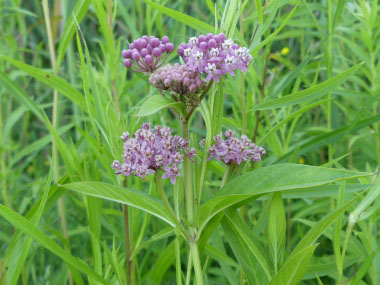
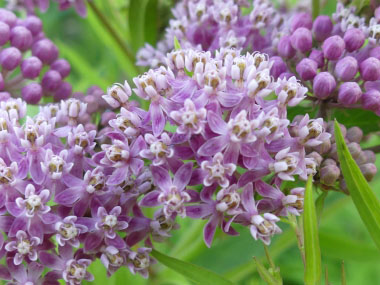
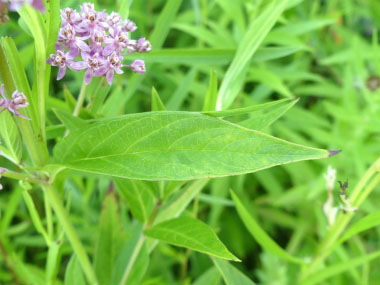
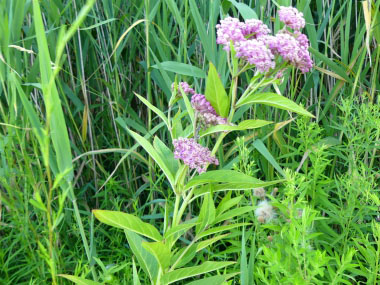
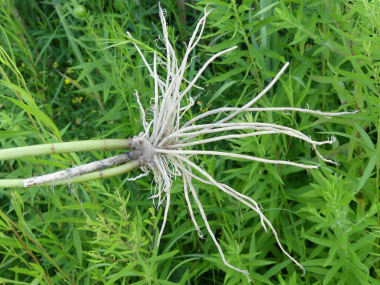
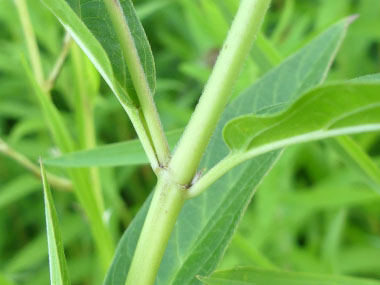
To support our efforts please browse our store (books with health benefits, etc.).
Asclepias incarnata is in the milkweed family (Asclepiadaceae) and is native to parts of Canada and the US. 'Incarnata' was likely included in the botanical name because it means flesh-coloured or flushed with pink, which describes the colour of swamp milkweed flowers. The Pueblo harvested fibers from this plant and used them to make fishing line and sewing thread. Roots of swamp milkweed were used in the treatment of various ailments.
Distinguishing Features
Swamp milkweed can be distinguished from similar milkweeds by its (typically) pink-flowered umbels positioned at the tops of the plant stalks relatively narrow leaves, and moist habitat. It is also much taller than other milkweeds usually reaching heights of over 1 metre (3').
Flowers
Round clusters (umbels) of light pink flowers grow near the top of plant or at the top of brached stems. The flower colours may vary from near white to pink to lilac, and are pleasant smelling. Flowers consist of 5, downward-pointing petals and a 5-part central crown that are dull pink to deep pinkish-purple. Flowers are about 5 mm (1/4”) wide. They typically form small clusters of between 10 to 20 flowers. Swamp milkweed flowers anywhere from June to September depending on location.
 Fields
of Nutrition has medicinal benefits and vitamin/mineral content of Swamp Milkweed.
Fields
of Nutrition has medicinal benefits and vitamin/mineral content of Swamp Milkweed.
Leaves
The opposite leaves are up to 15 cm (6") long and 4 cm (1½") across, although they are more typically half that. They are narrowly lanceolate or oblong-lanceolate in shape, smooth along their margins, and glabrous. Upper leaf surfaces are medium to dark green, although they can become yellowish green or pale green due to bright sunlight and hot dry conditions. The leaves are either sessile or their bases clasp the stems.The leaves have a tendency to become more broad in shape in response to shady conditions.
Height
Swamp milkweed grows anywhere from 30 to 150 cm (12 to 60”) high. Stems are erect, stout, (some may branch) and have few, if any, hairs.
Habitat
Swamp milkweed habitats include open to partially shaded areas in swamps, thickets, moist black soil prairies, low areas along rivers and ponds, fens, marshes, and drainage ditches. It can be found in both high quality and degraded habitats. Swamp milkweed grows (in Canada) from Manitoba to the east coast and in most continental states with the exception of west coast states.
Edible Parts
All parts considered edible must be cooked. Unopened flower buds, young shoots and young seed pods (harvested when 3 to 4 cm long) can be consumed in small quantities and ONLY if cooked. The flower clusters can be boiled down to make a sugary syrup.
Other Name
Rose Milkweed.
Similar Plants
Winter Survival Food Handbook

PDF Plant Magazines
Types of Wild Food
Geographic Zones Seasons
Disclaimer
EdibleWildFood.com is informational in nature. While we strive to be 100% accurate, it is solely up to the reader to ensure proper plant identification. Some wild plants are poisonous or can have serious adverse health effects.
We are not health professionals, medical doctors, nor are we nutritionists. It is up to the reader to verify nutritional information and health benefits with qualified professionals for all edible plants listed in this web site. Please click here for more information.
Why Edible Wild Food?
- Food costs are rising
- Free, wild food is readily abundant
- Wild food adds nutrition to your diet
- Wild food can help treat various medical conditions





